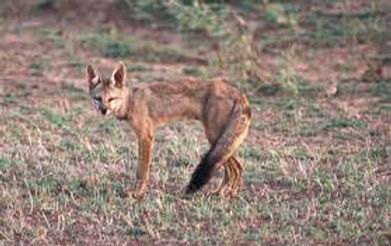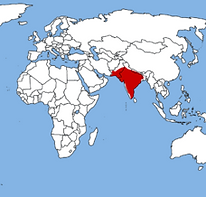Bengal Fox(Vulpes bengalensis)
They are also known as the Indian Fox. It is a relatively small fox with an elongated muzzle, long, pointed ears, and a long, bushy tail. The pelage ranges in color from buff to silver-gray with an overall grizzled effect; the dorsal pelage is mostly grayish and paler ventrally. The legs tend to be brownish or rufous, and the underparts light, a pale sand or ginger shade. The Bengal Fox is more daintily built than the red fox and can readily be recognised by its bushy, black-tipped tail, which is around 50–60% of the length of the head and body.

The backs of the ears are dark brown with a black margin, and white inside. The ears have the same colour as the nape or maybe darker, but not having a dark patch. Its rhinarium is naked and the lips are black. The muzzle is pointy, and there may be a dark smudged marking along the upper part of muzzle in front of eyes. Extensive variation in coat colour exists across populations and seasonally within populations, but generally varies from grey to pale brown. The head and body length is 18 in, with a 10 in long tail. Typical weight is 5-9 pounds.
Habitat
The Bengal Fox is endemic to the Indian subcontinent, ranging from the Himalayan foothills and Terai of Nepalthrough the South portion of the Indian Peninsula (but the western and east Ghats are not included) and from southern and eastern Pakistan to eastern India and southeastern Bangladesh. In Nepal and northeast India, it occurs up to 1,500 meters long. It was not reported from Afghanistan or Iran or from the Western Ghats, India.

Its range is bounded by the Himalayas and the Indus River valley. It favors semiarid, flat to undulating land, bush and short grassland habitats. It avoids dense forests, steep terrain, tall grasslands and true deserts. It is relatively widespread in low rainfall areas where the vegetation is usually scrub, thorn or dry deciduous forests, or short grasslands. In the Indian peninsula, the species is confined to plains and open scrub forests. It was considered to be a habitat generalist, but it shows a strong preference for semiarid, short grassland habitats at multiple scales.
Diet
Bengal foxes are omnivores and are opportunistic feeders, mainly feeding on birds, rodents, reptiles, eggs, insects and fruit.
Breeding
Bengal foxes are usually monogamous and form pair bonds that may last for their lifetime. The breeding season is from December to January, announced by digging a new den or re-excavating an old one. Pups are born from January to March. The gestation period is 50-60 days, and between 3 to 6 kits are born within a den. Both mother and father help to raise the kits, which are weaned at about 1 month old. The young are sometimes nursed by a number of females. In the daytime, they are likely to rest under bushes, but in summer they rest in dens. Independence is reached at 4-5 months old and sexual maturity by 1-2 years old. Play between pups is typical during the first 3 months and consists of vertical jumps, back arching, foreleg stabs, submissive displays, and play solicitation; the adult male sometimes plays with the young. In northwestern India, young people are scattered during the monsoon season, when the opportunities are plentiful. Pup mortality is high during the first few months.
Population
According to the IUCN Red List, they are classed as Least Concern(LC). Although widespread, the Indian Fox is nowhere abundant in its range, with densities greatest in semi-arid grasslands of peninsular India. Densities seem to track rodent abundance, which fluctuates widely between years in the species' prime habitat (arid and semi-arid zones) . Densities of breeding pairs ranged from 0.25–0.4/km2 in the Kutch area of Gujarat.
Threats
Although the Indian Fox is widespread, it occurs generally at low densities throughout its range, and populations can undergo major fluctuations due to prey availability and disease (rabies and canine distemper virus have been recorded to cause local population declines in western India). They can tolerate some human disturbance, although with expanding human populations and continued development of grasslands for agricultural and industrial uses, the habitat of the Indian Fox is continuously being depleted. The combination of above factors along with disease and/or natural mortality could potentially cause localized extirpations. In certain states like Gujarat, Maharashtra, and Rajasthan, Indian Fox habitat is widespread with minimal threats, while in other states like Karnataka and Tamil Nadu the habitats of the Indian Fox are under threat.
Conservation
Legislation
The populations of India are listed on CITES Appendix III. The Indian Wildlife Protection Act (1972 as amended up to 2005) prohibits hunting of all wildlife and lists the Indian Fox in Schedule II. It is not on any special category for protection in the wildlife legislation of Nepal.
Presence in protected areas
Occurs in protected areas in India and in Nepal, including Bardia National Park, Chitwan National Park and Shukla Phanta Wildlife Reserve. In India, the species also occurs in the Desert National Park in Rajasthan; Velavadar Blackbuck National Park, Kachchh Bustard Sanctuary, Narayan Sarovar Sanctuary in Gujarat; Sholapur Bustard Sanctuary in Maharashtra; Rollapadu Wildlife Sanctuary in Andhra Pradesh as well as several other protected areas.
Presence in captivity
The Indian Fox is held in captivity in several zoos in India, where the species breeds well. In 2001, there were 15 males, 14 females, and 11 unsexed individuals in several zoos.
Gaps in knowledge
A status survey is needed to identify areas throughout the species' range that have large, relatively secure fox populations. In some of these areas, an in-depth, long-term study is needed on population dynamics of the Indian Fox. This would help elucidate the fox's relationship with prey population cycles and disease outbreaks. Research is also needed on ranging patterns, territoriality, and behaviour of this poorly studied species.